<< Russia Conquers Flattened Cities: Cause and Effect
Attacks on Apartment Blocks and a Russian Supply Column in Borodyanka
March 11, 2022 (a bit rough)
Introduction
Dmytro Kuleba, Minister of Foreign Affairs of Ukraine, tweeted, on March 3: "Each time when Russian liars say they don’t drop bombs on Ukrainian cities, show this photo of a residential apartment building in Borodyanka, Kyiv region. Russians bombed the town for two days, killing many civilians. Stop barbaric Russia now. Close Ukrainian sky. Act now!" There's a photo of a building blown up, along with a claim the Russians did it, beside much else (but nothing that made such a dramatic single image), and soon after agreement reached that the Russians now occupied Borodyanka. That should suffice to convince most people what happened and why.Attack site video: Maksim Levin, Reuters, drone footage - widely used by other sources and viewed now many millions of times, mainly just to add random specificity to kneejerk impulses to blame Russia for the worst possible version of whatever actually happened here: https://www.youtube.com/watch?v=VI1G-UD95yw
 Again, the town is Borodyanka (Ukr: Бородянка), about 20km northwest of Kiev. I geolocated the one building easily, on the main street Vulytsya Lenina, middle west edge of the city, across from the monument to poet Taras Shevchenko, and near the highway to Kiev. On Google Maps, it's labeled "Vulytsya Lenina, 353" - coordinates: 50.6435566, 29.9345456 (Google maps). It included a hostel, maybe ground floor businesses, but probably many regular apartments as well. At right, matched features, rough mapping: red star is attack site - the the Zdvyzh river seen in footage is just lightly marked here SE of town, canalized into the fields. There's Kiev and its suburbs to the southeast.
Again, the town is Borodyanka (Ukr: Бородянка), about 20km northwest of Kiev. I geolocated the one building easily, on the main street Vulytsya Lenina, middle west edge of the city, across from the monument to poet Taras Shevchenko, and near the highway to Kiev. On Google Maps, it's labeled "Vulytsya Lenina, 353" - coordinates: 50.6435566, 29.9345456 (Google maps). It included a hostel, maybe ground floor businesses, but probably many regular apartments as well. At right, matched features, rough mapping: red star is attack site - the the Zdvyzh river seen in footage is just lightly marked here SE of town, canalized into the fields. There's Kiev and its suburbs to the southeast. What question can I even have here? Why would the Ukrainians bomb their own city? It seems absurd. After all, the Russians are the ones invading with heavy weapons, taking over cities, making them theirs. And everyone knows Russians would totally bomb their own cities, because unlike the noble and civilized Ukrainians, they are cartoon villains. Right? I'm not trying to defend the overall invasion and war Russia has initiated here, but to remind that they are not cartoons, and may have reasons for what they do, and might not do all they're accused of.
As I will explain below, as of these 2 days of "Russian bombing," Borodyanka was not the "Ukrainian city" you'd think, and had in fact been Russian-held for a week. And is anyone confused why Kiev's forces might attack a Russian army supply convoy? One was seen destroyed in the same city, just a few blocks up Vulytsya Lenina from these two buildings, in an attack that also damaged and burned nearby civilian buildings (but not these 2). The violence was not all that one-sided.
In fact the available visual evidence suggests that supply convoy attack was launched from civilian buildings very near VL353, leading a Russian tank to fire back, before the tank crew was apparently killed or captured, amid a span where that Russian occupation was clearly challenged, anyway. Such violence may have been escalated to the flattening of these buildings soon after, without any cartoonish villainy needed, and Russian control was upped to a new, undeniable level soon after that.
But even this is worth questioning. So far there's no real basis to presume what happened without some clear evidence, some of which can be obtained from the visual record. For the most part, the camera still doesn't lie.
Russian Control: Before March 7
An official situation map of Kyiv Oblast (region/province) issued March 7, and no earlier ones that I've seen, acknowledges this and all cities in all districts northwest of the capitol as Russian-occupied or now, as at Irpin, under attack and likely to join. Cropped version here with added labels. For the preceding week as those apartment blocks were destroyed and as so much else was wrecked, the situation has been kept less clear; Borodyanka was described in Ukrainian statements and news reports as both "Ukrainian" or "our city" and also as held, at least somewhat, by "the Russian occupiers."Most sources agree on a general Russian control over Borodyanka since day 4 of the conflict, February 27. The well-informed Institute for the Study of War seems to have the city under Russian control from Feb. 27 (map). The surrounding area of control shifts a bit over the next days, but this town seems to stay in the red constantly to and past March 3 (map). See a crop of both layered below, correlated by me with other maps - it's accurate, except maybe "attack from SE" - see below). By the 3rd, when this happened, ISW shows Russian forces held turf up to about 10km to the southeast, or halfway to Kiev (Kyiv) city limits. (there will be better maps for this)
A geolocated video, 2/27 shows Russian forces in Borodyanka - not checked, but likely so - said to be 50.639864,29.918696 https://twitter.com/YWNReporter/status/1497899149697638401 2/28 soldiers getting out of some tanks somewhere in the city https://www.youtube.com/watch?v=vZuX7mlg1Hc
So right away Russians could at times operate freely with no resistance and no massive bombing of the city required. Of course, local resistance could grow, non-local resistance could be brought in, etc. Some reported Russian attack on 2/28 affected civilian areas, but the worst damage shown is some splintered wood - maybe after the Russians hit a nearby location of some sniper fire, for example. https://twitter.com/olex_scherba/status/1497581970825560065
As Kuleba said and as generally reported, the apartment attack came after "Russians bombed the town for two days" - March 1-3 - long after they had established this general control. Images and videos of the 1st and 2nd show various often heavy damage to buildings that are on fire, and at least one other collapsed apartment block. I have yet to see any much footage of these buildings until the 3rd, after the attack. I'm not sure when that happened, but not long before that drone footage, in which fires are still burning - perhaps late on the 2nd, overnight, or early on the 3rd. And after such a finale, it seemed possible the fighting was done, the Russians presumably left in charge.
The Russian Supply Convoy
In the convoy: a seemingly unscathed tank furthest ahead, now abandoned, seeming ransacked, and a smaller, likely civilian truck, badly charred - ten military trucks including a fuel tanker are clustered mainly a little to the north, in front of what Google Earth says is a post office (blue roof). Two craters seen in the pavement ahead of each cluster of vehicles including a fuel tanker and a truck full of replacement wheels, and one truck alone in between seems to have taken a direct hit, probably from a mortar. There should be a 4th impact at the main trucks cluster by the post office, which is as burned as these trucks some ways from that orange circle. but I somehow didn't notice it yet.
This presumably Ukrainian attack is close to the building attack, but I think too far away to directly relate to it - most of the trucks north of this block stopped while headed south (others would try reversing if able). So they didn't drive some ways after they were damaged there - these were almost certainly two distinct incidents. In fact some footage relating to the convoy attack (see below) was posted on February 28, California time - likely March 1 in Ukraine. (upload times may be worth checking next).
This was clearly a supply column headed south when one of the lead vehicles was hit. Ideally, supply lines run through areas you have some control over and/or where you enjoy local support, or at least limited organized hostility. Otherwise is to invite ambush - which might be what hit them, one way or another, and whenever. The damage sustained seems light; tearing a few cab roofs halfway off, starting a lot of fire - maybe it was a drone like this, but armed.
New footage of Borodyanka emerged March 7 with a Komsomolskaya Pravda video. This comes from Russian media, maybe you aren't allowed to hear this. If so, look away. Reporter Alexaner Kots, seemingly "embedded" with the Russian military, is seen walking the same area, passing the post office, then heavy fragmentation marks on the wall and ramp next to the north crater - the street is now totally cleared with none of the old wreckage visible, allowing traffic that's almost entirely military at the moment - no signs or sounds of new conflict.The Battles of Last Week: Russia's Side of the Story...
...per Alexaner Kots, anyway, in his reports of March 7 or so. Citing the video above plus:
https://www.kp.ru/daily/27373/4555356/
https://www.youtube.com/watch?v=QbNPnxwceTo
He explains this city Borodyanka was "not so long ago taken under the control of the Russian army." He sees around "skeletons of armored vehicles and trucks. Whose they are - Ukrainian or Russian - can no longer be understood, but there was definitely no cake walk here. Sometimes there are crumpled civilian cars." There were only a "frightened few remaining residents." - Kots and locals he speaks to refers a lot to WWII (the Great Partrioctic War) and the perceived Nazi identity of the new government in Kiev. Of course they claim to be happy they've been liberated from that control, albeit tempered with the pain of this process and worry about what the future holds.
As Kots heard from his sources (local and/or military) the initial Russian occupation here was interrupted in the following way:
"At first, the population was [plagued] by armed looters, who in Kiev were given assault rifles with ammunition. Then units of the National Guard and nationalists came here, arranging a firing point from almost every residential building. And when the Russian troops pushed them back to the south, the Armed Forces of Ukraine covered Borodyanka with artillery, sparing neither barrel artillery shells nor Grad MLRS rocket munitions.
Now the village differs little from any front-line village near Donetsk or Lugansk.
As the Russian public knows, frontline villages get shelled all the time, suffer wounded and dead, power outages, and more on a regular basis. Ukraine usually denies responsibility, accusing the Russians or the separatists themselves (e.g. Mariupol, Jan. 2015). Kots says "unlike the Donetsk residents, who by ear determine the caliber and direction of the "surprise" that has arrived, the locals do not yet understand either the types of weapons or amateur ballistics."
It's suggested that now Borodyanka has slipped from Kiev's grasp, it might be seen the same way. In such a case, they might sow some destruction on their way out as a sort of target denial, to spoil Russia's prize, leave them with a huge mess to clean up, and of course to pin the blame for it all on them. This scene at VL353 especially is sold as proving the occupiers had to flatten the city to impose their brutal will on a resistant people, in line with the Kiev-NATO narrative.
claims of government-armed looters and Ukrainian shelling will be widely dismissed out-of-hand with laughs - on the former, it was alleged the Russians did the looting, we could say people are people and either way, and it's not immediately relevant. Implicating the hated nationalists is both realistic and also conceals any authentic local resistance they faced (it was probably a mix).
But why would the Ukrainians - even the "Nazi" ones - shell their own city? Why have they done that so many times before to others of "their cities" in the east? You got your few friends out and it's enemy territory now? That plus this time everything's being scaled-up to Russian / WWIV size?
Kots also mentions the Russian military's own actions, in less detail ("pushed them back to the south"). It's not clear if the attack on the apartment blocks would be included in the Ukrainian shelling, or if that might be some of their own destruction preceding it. For example, maybe insurgents had attacked their forces several times from there and finally a massive airstrike was called in to take out all the attackers, along with the middle half of two large buildings.
The Convoy Attack, on Video?
Some scenes from this peaceful city during the first days of Russian occupation might give us an idea what makes sense; A morning video taken from a furnished civilian home across from the Shevchenko monument, probably from middle building next to VL 353 - tank firing near the square, unclear what at but it's down the street to the southwest, as other tanks drive by https://www.youtube.com/shorts/XpLs-CMh_VE - in another video said to be in Borodyanka but not geolocated, a man in a vacant building with a possibly military radio drops a smoke grenade into an armored vehicle passing below before the video cuts off. https://youtu.be/WwsDEy9UOMU
combining these, maybe such insurgent attacks occurred at VL 353, making it the target of defensive fire? To hit the convoy we've seen, for example ... it's pretty close but at an oblique angle from most windows - none face north up the street - corner balconies might offer a good view, but those are vulnerable and other buildings might provide a safer base for such.
Another widely-seen video seems to play in directly here by showing that attack itself, at least partly launched from a different building: "The occupiers do not stop shelling: a powerful explosion in Borodyanka" (translated). Posted March 1, filmed then or earlier https://www.youtube.com/watch?v=hVgp4yrUIJw - specific upload times on all these videos might be a good next step.
On a sunny day around noon, a lone man films as a tank fires at his position - a completely vacant room with this great line of sight on Russian military vehicles up the street (the same Vulytsya Lenina we've been looking at - see correlation below). I'm not sure just where this is, except that it's a block or more west of VL 353, in fact seeing that whole set of 3 apartment blocks obliquely on the right (pink box). They're not fully visible, but don't seem blown-up yet.The tank shell rips across a low nearby roof before hitting a wall just below the cameraman's position, shattering glass at his window. He barely flinches, as if battle-hardened; he just leans out of the way and silently re-assesses his views, trying another window. Someone, sometime, scrawled a peace sign on the wall between these windows.
Possibly related: there is a lot of thick, black smoke filling the space behind the tank, maybe around the Post Office (blue box), and perhaps over the same span as they burned supply convoy we'd see ~48 hours later, including as it did a fuel tanker and a truck full of tires. It seems that attack has just happened. The tank seen here may be the same one seen later, after falling back just a bit. In between this video and the end was another probable mortar hit in the pavement about where the tank was, destroying that smaller truck (orange dots for the impacts noted above).
This suggests the cameraman was involved in that attack, launched from his position just moments earlier. No sign of weapons or other people appear in this short view, and while I can't prove this relates to the attack, it's only logical. Why would a tank guarding a supply column that was just destroyed fire a certain direction unless that's where the attack came from?
As Kots related the story from the Russian side, "units of the National Guard and nationalists came here, arranging a firing point from almost every residential building." Russian lies to justify their senseless brutality?
Then, some locals and/or fighters had unfettered access to the attack site over what seems a full day or longer. Some videos following a light snow, one shows related fires still burning, one shows a dead Russian soldier, while most do not - someone else has been there, going through materiel, probably seizing some weapons, likely taking some prisoners.
More scenes: https://www.youtube.com/watch?v=zmNVsfPAeDo - https://www.youtube.com/watch?v=J5wFJ9RB0I8 - March 1, dead soldier, face shown (Asiatic features), no visible injuries https://www.youtube.com/watch?v=TnCXz60K70g
These videos got to Kiev-linked sources - the Russians with the broken supply line aren't fully in control here at this time. They're nowhere to be seen.
short clips compiled: snowy scene, body invisible, and below: twilight, AM or PM, trucks done burning, but post office still ablaze, almost surely due to this attack - https://www.youtube.com/watch?v=eiuCyPP_UMQ - Feb 28, Youtube time - alt: https://www.youtube.com/shorts/jRVYHFMpU98 - https://www.youtube.com/shorts/BC5JNTRoTIc
Ukrainian news channel TSN ran some of this footage to illustrate the story "The bodies of people are being pulled out from under the rubble in the town of Borodyanka, Kyiv region." Other scenes of devastation and rubble in the city are shown, but just one body: the Russian soldier. TSN explains: "On the eve of the Russian occupation" - the unchallenged one, not the one already in place but plagued with violence for a week. Just today, "a missile strike destroyed two high-rise buildings there." As noted below, actually, IF these were missiles, it appears they were huge and came from the southeast. "Data on the number of victims are still being clarified. But locals say the scale of the destruction is much greater. According to them, the occupiers" - of that town, not just parts of Ukraine in general - "have carried out three air strikes since yesterday" on a base of their own operations, for no good reason?
Conclusion: So What Happened at Vulytsya Lenina 353?
Considering the precedent we just established, some damage to Borodyanka will have resulted from the insurgent attacks launched from these civilian buildings and the expected defensive fire that brings. It's likely that's what took out a north corner balcony at Vulytsya Lenina 353 prior to the big attack (red) - and another one two floors above it (orange) ... and the top balcony corner suffered lighter damage as well (gold). This was at least glimpsed in a video following the convoy attack but before the apartment block attack; someone filmed same damage at VL 353 - the same badly-damaged balconies with a good view up the street. Note the relatively flimsy balconies would have to be used as there are no windows in the north-facing wall. Orange label: damage pre-existed, but the new blast, probably, shook the unanchored wall even looser.Some more expert military analysis could settle this better than all my barely-informed guessing - but all considered, I really can't say who did this with what weaponry. The simplest answer is Russian forces bombed them to stop insurgent attacks based there. But the scale is questionable, and works to Kiev's propaganda advantage to show the Russians ruling over total devastation. And, harsh as it is, they might have other motives; whoever could decide on such false-flag attacks - with or without Kiev's express approval - might consider those former Ukrainian citizens to be expendable enough to risk killing and maiming them just to wreck Russia's prize, give them a huge, expensive mess to fix, and create new suffering with which to demonize them.
Consider what happened in Okhtyrka just before and especially after Russia's decisive takeover on the 28th - they did that by destroying the army there, and then once it was a Russian city, they blew up its power station and a bunch more homes. According to Kiev's retreating forces, anyway.
Keep in mind that Ukraine's new post-Maidan regime is not an extremist Nazi one, as Putin's wartime propaganda shorthand puts it. I won't say that's a "lie," because it totally has that element, has in the past given it free reign, and might even now be helplessly subverted to it, despite the face Zelinski puts on it so far. And it's in hardcore frontline places like this where the Nationalist paramilitaries (like the famously neo-Nazi-identifying Azov Battalion) often come front-and-center. When I think "the Ukrainians" possibly doing something like blowing up Borodyanka just for effect, that's who I mean, and it seems plausible to me.
And it also remains possible that the Russians bombed their own city, even to their own detriment (vis-a-vis public relations at least), with some criminally inadequate reason. But the way this was presented as the only option, the obvious reality, and proof positive of Russian malevolence only serves a propaganda narrative, not the cause of truth and justice.


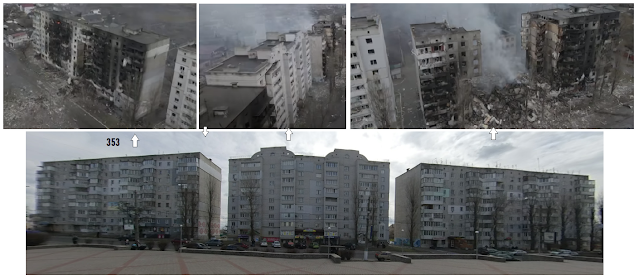
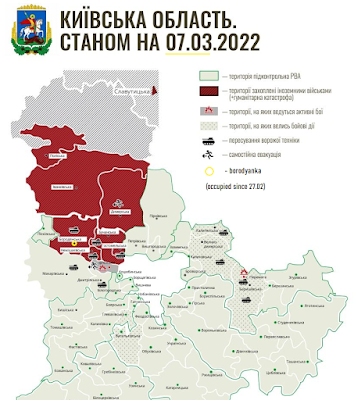

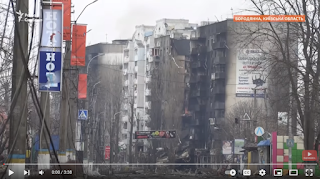

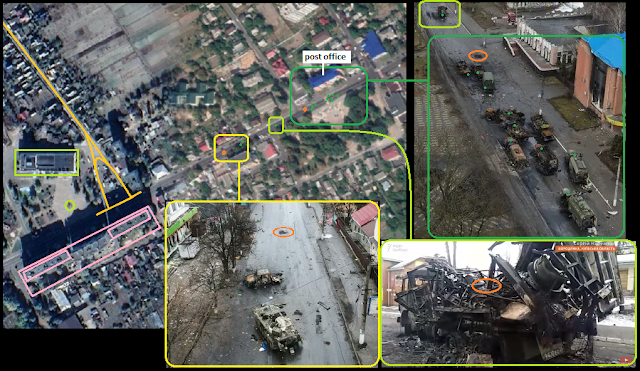

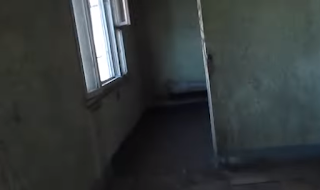








I have been far too busy to pay any attention what is said or claimed in Western media, but saw a 1 minute video of the scene in some British media a week ago. It seemed immediately clear to me what had happened: a Russian convoy was ambushed by Ukrainians, possibly using the new British / Swedish anti-tank missiles. (The drone video also showed the burnt-out trucks.)
ReplyDeleteI do not think that the buildings could collapse from artillery shelling alone. There is only one event (actually two) that could cause such huge destruction. A Russian main battle tank or ammo truck was hit by an anti-tank missile and blew up, taking the building with it.
(There is a precedent: In Donetsk the main road to the airport crosses the railroad line over a huge bridge. The bridge blew up in the winter of 2014-15. The reason: a Ukrainian tank attack on Donetsk. DPR tanks were waiting in ambush under the bridge. On of them got hit, the ammo "cooked" and the whole bridge was gone.)
The other possible event that could cause such damage is a direct hit by a Tochka-U ballistic missile. They are usually fired in pairs, so it could explain the two collapsed buildings. Suppose the Russian tank column had stopped behind the buildings. If a Tochka unit some 70 km away was given the street address or exact coordinates on the map, they would not know that the high-rise buildings would block the flight path.
Hey! Tochka-U it might be. The convoy is was NE, seems headed towards the buildings, craters where they were hit there, burning the post office. At these buildings were snipers. Maybe Russia took out their perch, except not the corners they actually used (balconies there already blown out) ... or maybe Ukraine fired from the SE just to wreck the city and make Russia look bad again. There is also a truck in Borodyanka so blown up it might've held missiles when hit - half a missile laying there - can't place it yet. That could blow up one building if that's where it was, but not both. https://www.youtube.com/watch?v=Mi53hxg2JV4
DeleteAlexander Kots has a new video that explains the whole event:
DeleteJust look how Kyiv "Tornados" (BM-30 Smerch) stacks residential areas in abandoned cities, trying to hit Russian columns. I continue to work on the Kiev front.
https://t.me/voenkorKotenok/32489
The Smerch has a 90 km range, even longer than the Tochka-U. The difference is that the Tochka has a high-explosive warhead while the Smerch warhead is cluster munitions. I did not think the Smerch would make such damage, but yes, if you fire 20 of them at the side of a building.
The KP video shows one submunitions dispenser part of a used warhead just southeast of the collapsed building.
What I said above still holds, The Smerch unit was given the coordinates of the target, but they had no way of knowing about the high-rise buildings in the flight path.
will check that video report if possible - thanks. But ... the option doesn't stand well. Many blocks from where the column was, they hit both buildings by accident, and ALSO hit the column where it was - all linked because it seemed convenient at first. Also above (sorry so long) is the convoy just attacked, burning up the street behind that tank, which fired to the camera = attack from about the camera, in town - and the blown-up buildings are visible, not blown up yet. That happened later, and just how is the (or a) mystery.
ReplyDeleteEach Smerch launcher has 12 rockets. A fully equipped Smerch unit has eight launchers — that makes 96 rockets. They are meant to destroy whole tank brigades at once, in one salvo. Everything within half a square kilometer will be destroyed. All the damage we see here can be explained by one salvo from one Smerch launcher.
DeleteThat may be less than 1/2 km, but most things between are not destroyed at all. 3-4 craters at the trucks/tank, shrapnel etc. at each spot, looking like mortar shells or small rockets, and 1/2 km or so of intact buildings to the SW, that huge damage. If one salvo, it was fired at several spots far apart. And also at different times (2+ targets, 2+ firings probably not a single
ReplyDeletesalvo anymore): building not hit yet when the column is smoking, after apparent attack from a building near those buildings to the SW. Smerch fire from there would hit the convoy if range allows, but the building would be hit on SW side or front, not the back/Kiev side. Has to be 2+ events.
Here is one version of events, machine translated from Russian. But unfortunately this does not explain who fired at the buildings and from where. The article says "GRADs", but the remains on the site are from the larger and longer-range Smerch or Uragan rocket systems.
ReplyDelete***
The tragedy of Borodyanka - Kievan Rus, March 21, 2022
Photo: The actions of the city's territorial defense led to the death of dozens of civilians under the rubble in the basements of multi-storey buildings
The defense of Borodyanka from Russian troops was entrusted to the head of the local city council, a businessman and hardened supporter of Poroshenko, Georgy Yerko. But the governor misunderstood the task and, contrary to common sense, decided not to defend the city itself, which did not interfere with the advance of advanced columns of Russian armored vehicles, but the approaches to Kiev on the Korosten-Irpin highway.
To do this, Yerko, together with the head of the local district military registration and enlistment office, decided to block the way for the Russian troops with old tires and wooden pallets, and to throw bottles with Molotov cocktails at them from the surrounding buildings and shoot from antique unshooted Kalash. It is not known whether they seriously hoped to stop the advance of the tank column with such a flank attack, but they managed to draw it into battle on the streets of their native city. The result turned out to be sad - unlike Ivankov, Polessky and other district centers of the Kiev region, Borodyanka took on the brunt of street fighting. The city center was destroyed.
The most terrible thing happened in the area of urban high-rise buildings. When it became clear that the night battle was approaching the skyscrapers, the Nazis from the Monolit sports club and the local federation of ultimate fighting, which, by the way, were led by the mayor’s son Roman, “persuaded” the residents of panel houses to go down to the basements for safety reasons, and they themselves arranged their apartments and on the roofs of houses firing points. Not only machine guns were used, but also grenade launchers with mortars, ammunition depots were set up in the entrances, and someone the smartest (most likely the head of the police department) reported to the regional headquarters of the defense that the Muscovite tanks had fallen into a trap and they could be destroyed by fire artillery. And in the center of the city, “grads” began to work.
Most of the missiles, like many in the Ukrainian army, turned out to be defective and did not explode. They still lie on city streets. But the two explosions probably detonated the arsenals on the first floors, causing entire driveways to collapse like houses of cards, dooming the people in the basements to death under the rubble.
Russian troops withdrew from the city. When morning came, cries for help were heard from under the ruins. According to Nikolai Ganin, a resident of Borodyanka, up to a hundred people could be in the cellars. However, instead of urgent measures to save people, the defense, together with the units of the Armed Forces of Ukraine that approached, decided to engage in sniper shootouts with looters, using the roofs of the surviving houses for this and not letting rescuers, firefighters and volunteers into the ruins. The time when it was still not too late to organize the rescue of blocked people, to call construction equipment and professional rescuers, was mercilessly missed.
Residents left the unviable city, where there was no water, no gas, no electricity. Among the first to leave Borodyanka was the leader of the territorial defense, Georgy Yerko. When, a week later, units of the National Guard entered the deserted city to stop looting and restore order in the rear, pensioners from nearby private houses told the Russian military a terrible story about people buried alive. But from under the rubble, no one called for help.
Interesting, thanks.
DeleteA fresh drone video from Borodyanka:
ReplyDeletehttps://twitter.com/antiwar_soldier/status/1512577599876341763